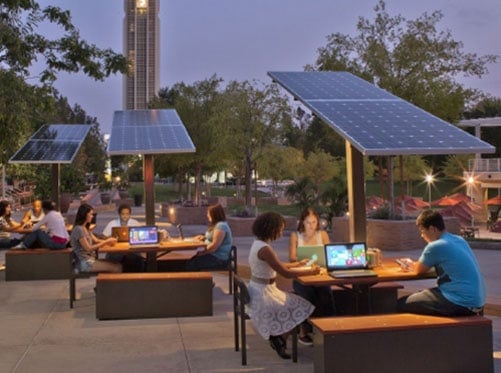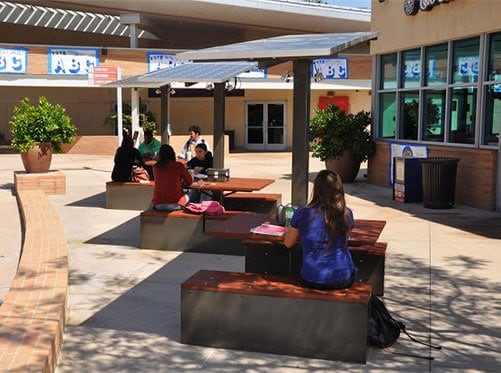In the past, incorporating solar panels into existing energy infrastructure, while idealistic, was unfortunately impractical.
The technology was expensive and inefficient.
But it’s 2020 and solar energy’s come a long way from its advent, which is very good news for homeowners, businesses and educators alike.
Now more than ever, solar energy is appealing to those wanting to be environmentally friendly (and shouldn’t that be everyone nowadays?), for its dependability and especially for those in education wanting to lead by example.
Here are five reasons why schools should go solar:
1) It’s all About the Benjamins
The most obvious upside to installing solar panels are the financial benefits. Aside from the initial investment, there are very little costs associated with integrating them into existing infrastructure.
The Solar Energy Industries Association report Brighter Future: A Study on Solar in US Schools explains how typically these systems are connected to the grid, with any excess power being sold to the utility company and credited towards your next bill.
Schools then have the potential to save significantly on utility costs, putting much needed money back into their budget for more important things, like I don’t know…teachers? Hiring great personnel shouldn’t be compromised and solar panels would help accomplish that.
2) Energy Independence
Just like colonial America declared its independence in 1776, making the switch to solar energy allows schools to break free from their dependence on carbon-rich fossil fuels.
According to Union of Concerned Scientists, solar energy is considered “clean” and is responsible for little to no pollution when compared to traditional energy sources, making our water safer to drink and air better to breathe.
Every day, people around the globe make small choices to help the environment, from practicing the three sacred R’s (reduce, reuse, recycle for those of you less hip) to simply not littering.
The next step requires making bigger decisions to save the planet.
In a time when climate change and environmental health are of great concern, utilizing solar panels on campus can help reduce ones carbon footprint. Need we say more?
3) Green Energy Pioneer
Appearance shouldn’t mean everything, but the optics of being eco-conscious can do a lot for a school’s reputation (it’s okay, they have a lot to offer on the inside too).
Let’s face it, in general, schools are a lot alike. Setting themselves apart as innovators in the renewable energy game by installing a solar photovoltaic system, offers many schools a competitive edge.
At a time when schools fight for funding and relevancy, a focus on renewable energy and the environment is a big draw for potential students, donors, and educators.
So the news may cycle faster than a cheetah going after its next meal, but one thing that has proven staying power is being green.
What better way to stay current than leading the charge to a sustainable future?
4) No Power, No Problem

Let’s say the power goes out in the middle of the school day; what happens next? Well, if you happen to attend a school that doesn’t rely solely on the grid for power…almost nothing.
If not, the school day is interrupted until power is restored, wasting valuable education time. This may not happen often, but it’s certainly frustrating when it does.
What if something worse than a system failure or blown transformer happens?
In the event of an emergency caused by a natural disaster or large scale accident, schools often become emergency shelters, providing the community with a much needed safe haven.
The Sunshine State of Florida already has a program in place, SunSmart E-Shelters Program, which optimizes the partnership between schools and solar energy.
Solar panels help ensure these shelters maintain power, making it possible to run medical equipment, provide access to proper sanitation, even allowing for continuous communication which is imperative during any emergency.
Schools running on solar energy can be a crucial and often invaluable part of any community’s disaster preparedness plan. And that’s nothing to joke about.
5) Preach What You Practice
Solar energy offers more than just a cost efficient, eco-friendly and innovative solution to powering schools. It can also be a significant addition to any curriculum.
Science, technology, engineering, and mathematics (STEM) classes can easily be geared towards lessons on solar energy.
Students can research energy and the environment, mock up their own solar arrays, and even learn how the systems are installed.
At the collegiate level, there’s also a vocational training opportunity for students interested in solar energy careers.
Incorporating solar energy into the classroom can help pave the way for today’s students.
And you know how the saying goes, children are the future, so why not invest in them?
Overall, solar power is a heavy contender in today’s utility marketplace and for good reason.
It affords a very real opportunity for the education system to make a positive impact on the environment, while providing its students with a better experience overall.
The best part? It’s possible to accomplish all of this without breaking the bank.


